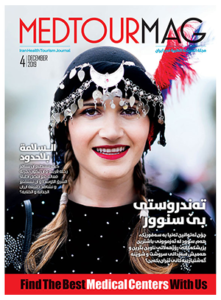The idea of returning to the pre-Covid world is becoming increasingly unlikely, in the wake of this, hospitals look to new post-Covid Strategies
When we think of the initial half of the year 2019, we all remember a very different world; one untouched by the ongoing pandemic, a more authentic and sane world. In came the COVID-19 virus and nothing remained the same. In many ways, the current pandemic has fundamentally and changed many aspects of the human life around the globe, with medical services sector finding itself in a swamp of demands and emergency cases, being overloaded in the process. The traveling industry simultaneously found itself shut down, people are either not traveling by their own agency, or otherwise are restrained from doing so by their states.
While initially the reaction of the medical tourism sector and the hospitals of the area were to treat the pandemic as a temporary obstacle, it is becoming more and more evident that the supposed “Post-Covid” era might never arrive. In the wake of this, the sector is realizing that COVID-19 is something that we might have to get used to and live with for years to come. With the possibility of a return to the old days now a feeble thought, hospitals have only one choice to maintain patient inflow and survive: Innovation. Here are the new post-Covid strategies that hospitals are using to attract patients.
Complementing the Growing Demand for Medical Information
While in the old days the majority of the patients were largely oblivious to standard health procedures and hospital protocols, this has changed rapidly following the pandemic. At this point in history, there is probably more demand for medical information than ever before. With the internet facilitating the information flow, people are storming the web in search of useful information, not just related to COVID-19 but in general. This is resulting in increasing volumes of casual hand washing and hygiene measures among the everyday people.
The courage and bravery that the frontline Covid fighter have displayed has elevated the public opinion and trust towards hospitals and doctors more than ever, as these are the people directly involved with the pandemic, as opposed to many other institutions. The stats show that people rely directly on hospitals and frontline Covid fighters more than any other institution as a source of information.
This has resulted in an unprecedented traffic to be directed toward hospital websites. Now is the perfect opportunity for hospitals to cement their reputation through providing large volumes of useful data on online and offline platforms, as people will remember these hard times in the future and come back to the very same hospitals that were of utility in the days of the pandemic.
Rendering Services for Consumers Directly Where They Live
Much like other services that have turned digital like online shopping, looking for a medical diagnosis and treatment service from a smartphone or computer screen is quickly becoming the norm for many people around the world. The trend towards shopping, working, and doing just about everything else from home was already growing prior to the ongoing pandemic, and now the patients are even more inclined to avoid traffic jams and crowded queue rooms following the Covid era.
Even for those who are not used to the digital nature that markets are leaning towards these days, we are witnessing gradual temptation on their part to try out these new online methods of meeting their needs. Even generations like baby boomers are showing more and more inclination to use these online services, which is quite complementary as this demographic is the one most likely to need medical services where they live.
While initially the reaction of the medical tourism sector and the hospitals of the area were to treat the pandemic as a temporary obstacle, it is becoming more and more evident that the supposed “Post-Covid” era might never arrive.
In the developing countries there is also a lot of room for growth as tech startups in cooperation with the hospitals of the private sector are working on implementing this method of rendering medical services as several medical centers in the m ferocity Middle and the Far East have successfully done so. With more and more people becoming aware of the utility, convenience, and quality of these online medical services, as well time and cost saving that it brings, patients from around the world are likely to continue trading analog medical services for digital resources after the COVID pandemic fades. Rendering direct medical services at the patient’s location, is not merely one of the post-Covid strategies for hospitals to attract patients, it might full well be a defining element of healthcare in the future.
Telemedicine
Telemedicine was previously largely used as a communication tool for pre travel consultations and maybe brief diagnosis sessions. Today telemedicine is not only a plausible and useful tool that can increase the market base of hospitals, it is fast becoming an integral part of the healthcare and medical tourism industries, so much so that many experts have openly professed that successful implementation of telemedicine is a condition that determines the future of medical tourism as an industry.
Related Articles: Future of Medical Tourism and Telemedicine
Telemedicine takes things into a new level, and avoids direct contact between the patient and the physician altogether, instead linking them across online and other platforms. The possibility of robot-assisted remote surgeries and complex medical procedures is no longer absent as such surgeries have recently been carried out. This eliminates much of the contact, traffic, waiting, and the need for travel and also facilitates all aspects of receiving a treatment to an unprecedented level. Without a doubt telemedicine will be one of the key post-Covid strategies for hospitals. In the future, a successful hospital would be one with a powerful telemedicine department.
Avoiding Inactivity and Starting Now
Shutting down departments related to “unnecessary treatments” and elective medical procedures is more so a pitfall to avoid, rather than a strategy for the post-Covid era, but it is such a common and basic act that many hospital are overlooking it. While the initial panic resulted by the pandemic resulted in many hospitals to focus their entire strength on combating the pandemic and shutting down other non-critical parts of the hospital, this is a dire mistake to keep making. Many hospitals are resuming their work in the other parts of the hospital: this is an important factor in the credibility of the hospital and showcases the competence of the medical center as it keeps on providing full-services even in times of a pandemic. In the post-covid days, this will serve as an excellent selling point for hospitals that started this procedure sooner than others and a complementary element towards other post-Covid strategies for hospitals.
Article by: Parsa Khaknezhad







